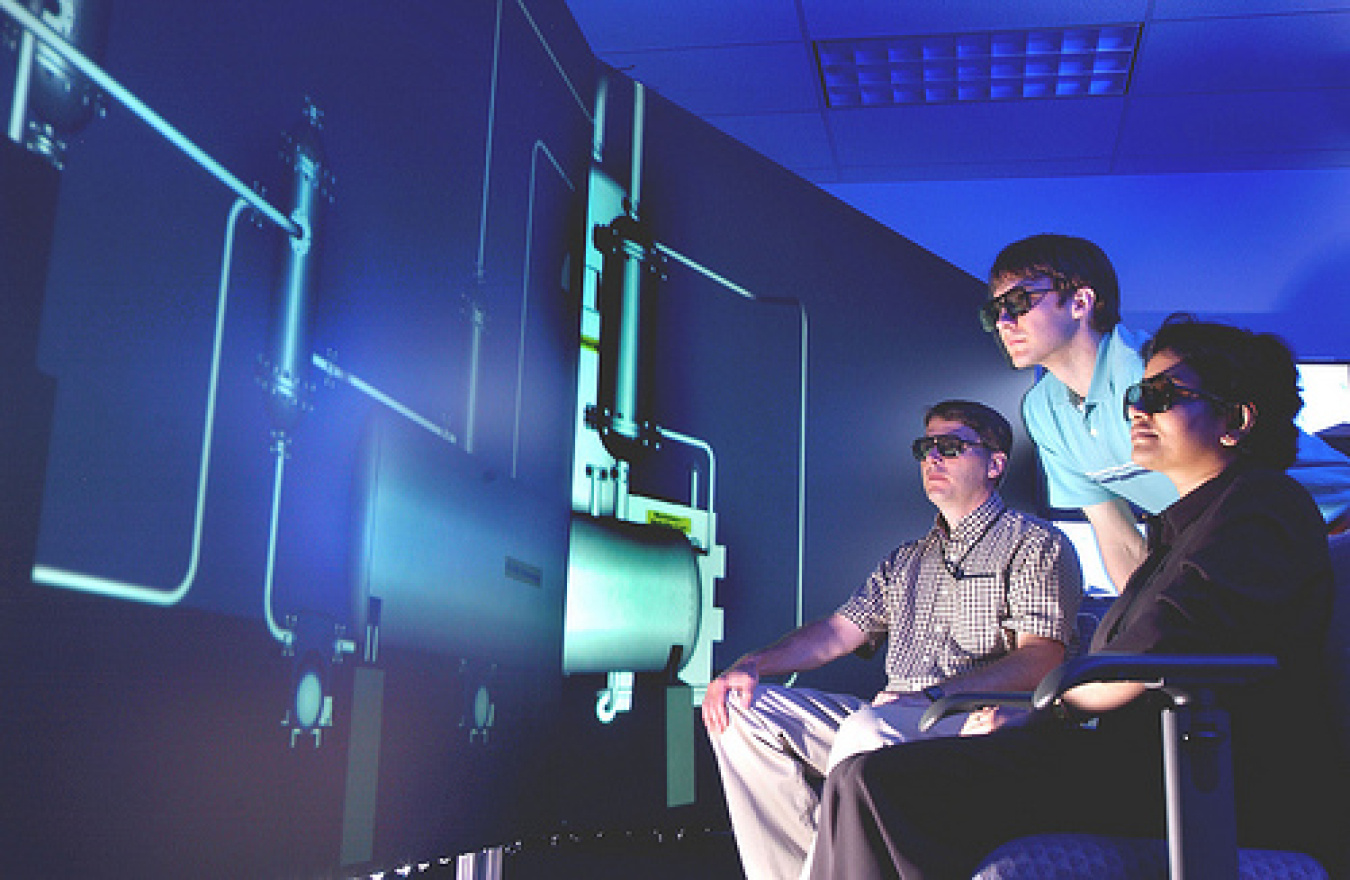
Computer scientists at FE's NETL study a visualization of a power plant component.
Traditionally the process of taking a new power plant system from the drawing board to a first-of-a-kind prototype has involved a series of progressively larger engineering test facilities and pilot plants, leading ultimately to a full-scale demonstration. The process can take over 20 years or more and cost billions of dollars.
Because of the significant efforts by DOE in the design and construction of advanced energy systems, traditions have changed. Engineers using sophisticated computer modeling and simulation are capable of "engineering" and testing new power processes well before the first metal is cut for a new pilot plant. Through the use of computational flow dynamics, 3-D visualization, process simulation and a host of other computational techniques, engineers are able to determine whether a new concept's physical and chemical systems perform as predicted, whether a future power plant's mechanical systems function properly, and whether the plant will succeed in meeting its efficiency and environmental goals - all displayed on a computer screen.
"Virtual engineering" is proving to be one of the most important innovations for proving the viability of new and untested power plant designs. While it may not eliminate the need for some engineering prototypes, it will almost certainly reduce their number, thereby compressing the time needed to develop and test new concepts and significantly reducing the cost of the research, development, and deployment process.
The strategy is to conduct computational research to provide insights into the complex interactions of physical and chemical systems encountered in advanced energy plants. High-speed computer simulation and modeling methods have been developed to advance technologies such as gas turbines, fuel cells, gasifiers, combustors, gas cleanup processes, and heat exchangers and the coupling of these devices together in clean efficient energy plants.
Computational Systems Dynamics
The Computational System Dynamics activity supports the development of immersive, interactive, and distributed visualization technology in the design of next-generation advanced power systems. These technologies are intended to lead to a suite of products capable of representing the operation of near-zero emission power plants, like gasification and oxy-combustion, which are based on validated models and highly detailed representations of equipment and processes.
These tools include advanced, distributed computer aided design tools for virtual design groups. System tools developed will allow the use of information technology in next-generation advanced fossil power systems. In particular, carbon capture is addressed through the initiation of a multi-laboratory carbon capture and storage modeling effort National Risk Assessment Partnership (NRAP). NRAP is a multiyear effort that harnesses the breadth of capabilities across the DOE national lab system into a mission-focused platform in order to develop a defensible, science-based quantitative methodology for determining risk profiles (and, hence, residual risk) at carbon dioxide (CO2) storage sites. These three collaborative efforts will accelerate CCS development and will support the goal to enable commercial deployment of CCS technologies by 2020.
Computational Energy Science
Computational Energy Sciences (CES) supports the optimization of the design and operation of heat engines, combustors, gasifiers, chemical reactors, and other important unit processes in advanced power generation systems. To this end, science-based models of the physical phenomena occurring in fossil fuel conversion processes are developed. These models have multi-scale, multi-physics simulation capabilities that couple fluid flow, heat and mass transfer, and complex chemical reactions. In addition, the Carbon Capture Simulation Initiative focuses on post-combustion capture, risk assessment, and integrated multi-scale physics-based simulations, and is designed to leverage existing expertise and funding. This multi-national laboratory collaborative effort will accelerate CCUS development and support the goal of enabling commercial deployment of CCUS technologies by 2020.
